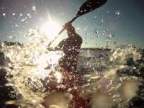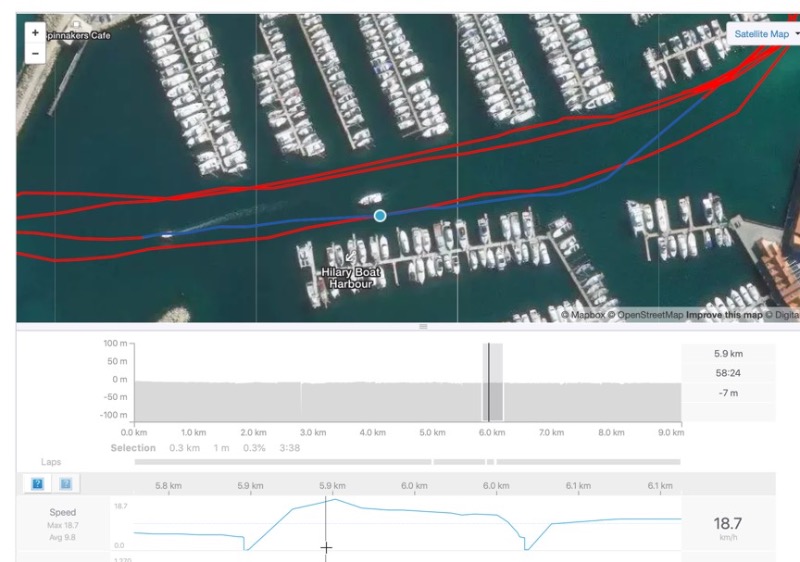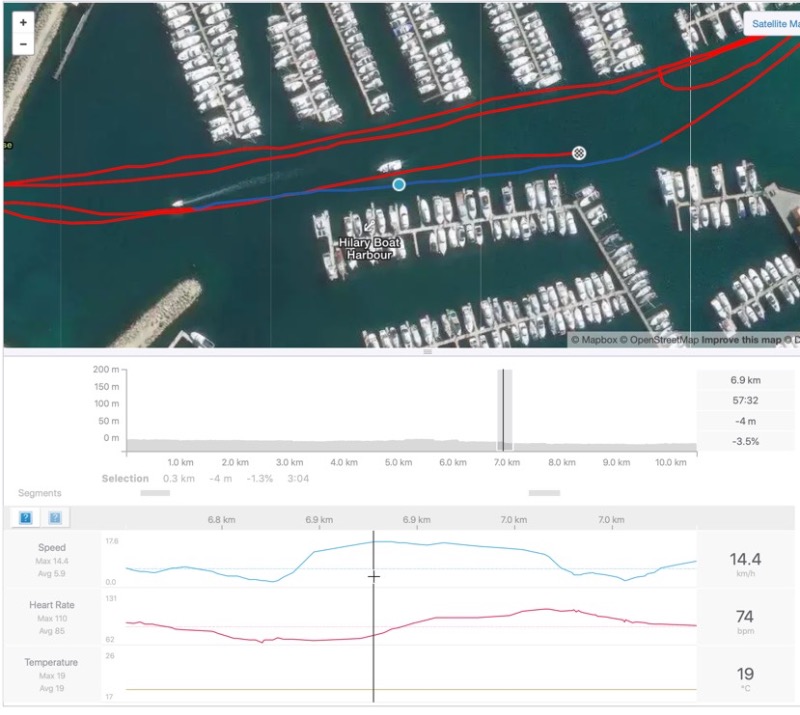- Posts: 302
- Thank you received: 66
Science behind speed and glide
Fat and heavy V7 a reluctant glider.
Please Log in or Create an account to join the conversation.
- SpaceSputnik
- Topic Author
- Offline
- Platinum Member
- Posts: 524
- Thank you received: 42
Please Log in or Create an account to join the conversation.
- uk gearmuncher
- Visitor
Please Log in or Create an account to join the conversation.
I think there are two aspects being conflated here.
1. Boat run
2. GPS latency
Boat Run:
It's been well known for a long time that a ski or kayak travels fastest during the brief moment after the paddle releases from the water, so long as (a) the blade is accelerated through the duration of the stroke and (b) the release is clean and to the side (not lifting water). In other words, the speed of the boat between strokes is largely dictated by the speed at which the paddle leaves the water. The duration of the "accelerated glide phenomenon" is rarely more than .25 seconds and by .5 seconds the boat has slowed to the point where a further stroke should be initiated to maintain a reasonably constant velocity. The higher that velocity, the more quickly the craft will slow due to the non-linear relationship between speed and drag.
GPS latency:
Most of us use small GPS devices such as Garmins or equivalent. These are great for measuring relatively constant speed and providing us with data for later analysis. They are not accurate for periods of rapid acceleration or deceleration. While they have improved in recent years, their latency is still typically in the region of 1 - 2 seconds, - driven by the time required for positional data acquisition and subsequent processing within the unit.
Consequently, if you accelerate your boat during the stroke, that acceleration will only register on the GPS after your blade has left the water. The longer you pause (up to the latency period of the GPS) the more pronounced this "Glide acceleration" will appear to be. The acceleration is real, - it just happened 1-2 seconds ago...
If we were all using RaceLogic or Leica GPS units, then the latency would be down in the 100ms range, but since we're not, we're stuck with the delays.
Don't stop using "pause paddling" as a training drill though (or even "micro-pause" paddling during a distance race). It allows you time to "set" your body position to optimise the power and efficiency of each stroke and let the boat work for you.
Please Log in or Create an account to join the conversation.
Without a doubt, the phenomenon that you are seeing is a byproduct of how your GPS unit computes speed. Below is a discussion of GPS speed that I have previously posted on this board.
A bit of a warninghere. GPS is a subject where I have significant technical knowledge as a result
of work. IMHO, the number one error of consumer level GPS users is to over
estimate the speed accuracy of GPS. Caution: Geeky Math Follows! GPS calculates
speed by determining the distance travelled between fixes and dividing by time.
At surski speeds (~7 mph), you cover approximately 10 feet per second, so to
get a good 2 sec speed reading, the unit has to be able to measure 20'
distances accurately. The problem is, GPS is not nearly that accurate.
According to the owner of the GPS system (US Government), consumer grade
non-augmented GPS receivers have an accuracy of about +/- 16' (the spec
accuracy is generally 30'). This means that when a GPS tries to give you a two
second speed reading, it will measure the distance as 20' +/- 16', which
results in a speed reading of 7 +/- 5.5 mph. GPS manufacturers recognize this
limitation so almost all add speed smoothing algorithms to their processors so
that you as a user do not see that much error. This is also why GPS units
significantly lag any changes like when you speed/slow while doing intervals.
From a technical standpoint, you need to be at a steady speed for about 30
seconds before the speed displayed on your GPS can be considered statically reliable
(<5% error). Very high end (Aviation and Professional Marine)GPS units are much better WRT speed for two reasons. First, they all employ augmentation (WAAShere in NA) which improves the average accuracy down to <1 meter. Secondly, they operate at a higherfrequency. Most consumer level GPSreceivers operate at 1 Hz, where high end units operate at 5 or 10 Hz. The operating frequency of a GPS receiver isreally more like the clock speed of a computer. A 1 Hz GPS calculates position once per second where a 10 Hz unit doesit 10 times per second.
Please Log in or Create an account to join the conversation.
- zachhandler
-

- Offline
- Platinum Member
- Posts: 764
- Thank you received: 189
Current Skis: Epic v10 g3, NK 670 double, NK exrcize, Kai Wa’a Vega, Carbonology Feather, Think Jet, Knysna Sonic X
Former Skis: Epic V12 g2, Epic V12 g1, Epic v10 double, Nelo 550 g2, Fenn Elite S, Custom Kayaks Synergy
Please Log in or Create an account to join the conversation.
However, I do take issue with the statement about 'there are no other forces on the boat once the paddle is out of the water'.
This ignores the lift of the boat. Unless the paddler is going very gently, there is a surge with each stroke, lifting the boat. As soon as the paddle stroke effort reduces, the boat starts to sink again. The lifted boat (and paddler), as a system, contains stored potential energy. The energy has to go somewhere! It might be into creating more wash, rather than motion, or, at some speeds (dependent on hull shape), it will produce a forward surge, as the boat surfs forward on its own wake.
Please Log in or Create an account to join the conversation.
- SpaceSputnik
- Topic Author
- Offline
- Platinum Member
- Posts: 524
- Thank you received: 42
Please Log in or Create an account to join the conversation.
Unfortunately I was racing a mate in a Stellar SEI G3 side by side the whole way (this point about 30 metres into the 100 after about an ocean paddle) and his Garmin data says:
Hmm my otherwise reliable Garmin 920 XT has me at four kmh faster at the same point as my mate with his Garmin Fenix (speed good but watch heart rate is BS though). And of course I wasn't getting windburn at nearly 19 kmh. All of my previous data has me here at about same speed between 14-15kmh. The real issue was GPS. So yes even independent of lag time and limited effective GPS accuracy by the second, sometimes data is outright incorrect for whatever reason.
Afternoon/evening paddle this evening Sunday flying upriver at mouth of the Swan (Traffic Bridge) 20 knot breeze at my back (very little fetch so really only ripples) - 9.5kmh!! Return journey into same fresh breeze, minimal resistance waves - 11.6kmh!! WTF? Significant tidal flow in still a wide part of the river makes a big difference.
Tide and wind variables in addition to GPS reception effectiveness also mess with data accumulation. I'm liking the V Box Sport a lot! Trouble is of course AU$600 plus. No honey, I absolutely need this one..
Attachments:
Please Log in or Create an account to join the conversation.
Please Log in or Create an account to join the conversation.
Also, - how many team-boat medals have been won with this concept?
Just asking...
Please Log in or Create an account to join the conversation.
- zachhandler
-

- Offline
- Platinum Member
- Posts: 764
- Thank you received: 189
RedBack wrote: Hmmm... as a matter of interest, - how many World Champions/Olympic Gold Medalists has Johnny Puakea trained with this "slow through the water and fast through the air" approach?
Also, - how many team-boat medals have been won with this concept?
Just asking...
I would guess zero because he no longer coaches K1. He currently coaches OC, and some of his OC athletes are world champions.
Current Skis: Epic v10 g3, NK 670 double, NK exrcize, Kai Wa’a Vega, Carbonology Feather, Think Jet, Knysna Sonic X
Former Skis: Epic V12 g2, Epic V12 g1, Epic v10 double, Nelo 550 g2, Fenn Elite S, Custom Kayaks Synergy
Please Log in or Create an account to join the conversation.
If you translate that to double-blade, then I think the equivalent would be 'take the blade out of the water fast, then dig deep and powerful in the stroke'.
It is well known that 'hummingbird' paddling (high stroke rate dabbing at the water) is inefficient and just results in lots of splashing. Powerful, short strokes are much better.
There is a very good paddler in my club, he grew up doing sprint K1 with a lot of formal training. In a 500m sprint session yesterday he pointed out to me that I was dropping my top hand when I was taking my blade out. Took some concentration to not do this, but what a difference! Stroke shortened, power went up - and the 'in air' part of the stroke lengthened. Make that quick, pause for the set up, pull hard, keep that top hand up as a fulcrum, lift pivot and lift with the lower hand; even this old man was giving the youngsters a hard time.
Please Log in or Create an account to join the conversation.
Please Log in or Create an account to join the conversation.
Please Log in or Create an account to join the conversation.
Latest Forum Topics
-
- Seat pads for practicing stability
- 13 minutes ago
-
- Surfski Width x Length Chart -May 2024
- 1 day 11 hours ago
-
- Do you change your paddle length for upwind and for downwind?
- 3 days 1 hour ago
-
- Nelo Vanquish Surfski
- 3 days 1 hour ago
-
- Gopro mast solutions
- 4 days 23 hours ago
-
- Paddling in Hawaii
- 5 days 2 hours ago



